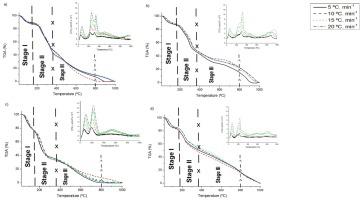当前位置:
X-MOL 学术
›
J. Anal. Appl. Pyrol.
›
论文详情
Our official English website, www.x-mol.net, welcomes your feedback! (Note: you will need to create a separate account there.)
Evaluation of models to predict the influence of chemical pretreatment on the peels of Nephelium lappaceum L. based on pyrolysis kinetic parameters obtained using a combined Fraser-Suzuki function and Friedman's isoconversional method
Journal of Analytical and Applied Pyrolysis ( IF 6 ) Pub Date : 2020-08-01 , DOI: 10.1016/j.jaap.2020.104827 João Daniel S. Castro , Erik Galvão P. da Silva , Cesário F. Virgens
Journal of Analytical and Applied Pyrolysis ( IF 6 ) Pub Date : 2020-08-01 , DOI: 10.1016/j.jaap.2020.104827 João Daniel S. Castro , Erik Galvão P. da Silva , Cesário F. Virgens

|
Abstract In the present work, two chemometric strategies were evaluated to assess the influence of the chemical pretreatment: a Kohonen self-organizing map neural network and a Support Vector Machine Learning algorithm. Kohonen ANN was able to predict the influence of chemical treatment mainly on pseudo-component lignin, since cellulose and hemicellulose have similar structures; presenting a topological error of 0.044 and a quantification error of 0.193, while the Vector Supporting Machine (SVM) algorithm was able to predict the classes with accuracy of 0.956, area under the ROC curve (AUC) of 0.992 and F1 score of 0.956, proving to be a more effective strategy in predicting the influence of the chemical treatment on the rambutan shells based on the kinetic parameters. It was also observed an increase in the activation energy for the cellulose pretreated with sodium hydroxide and with phosphoric acid, mainly due to the partial conversion of type I cellulose into type II cellulose, ranging from 152 to 155 kJ/mol versus 124 kJ/mol for the untreated sample. The thermal decomposition mechanism did not change significantly, being estimated as pseudo-zero order, using the Master-Plot method. TG-FTIR analysis reveals that the main gases emitted during pyrolysis are CO2, H2O and CO, being the carbon dioxide-related band an indicator of the influence of the chemical treatment. This analysis also reveals the release of sulfur compounds from the sample treated with sulfuric acid, indicating that the environmental point of view of this sample shows no viability as use as pyrolysis feedstock.
中文翻译:

基于使用组合 Fraser-Suzuki 函数和 Friedman 等转化方法获得的热解动力学参数,评估模型以预测化学预处理对 Nephelium lappaceum L. 果皮的影响
摘要 在目前的工作中,评估了两种化学计量策略来评估化学预处理的影响:Kohonen 自组织映射神经网络和支持向量机器学习算法。Kohonen ANN 能够预测化学处理主要对假组分木质素的影响,因为纤维素和半纤维素具有相似的结构;拓扑误差为 0.044,量化误差为 0.193,而向量支持机 (SVM) 算法能够以 0.956 的精度预测类别,ROC 曲线下面积 (AUC) 为 0.992,F1 得分为 0.956,证明基于动力学参数预测化学处理对红毛丹壳的影响是一种更有效的策略。还观察到用氢氧化钠和磷酸预处理的纤维素的活化能增加,主要是由于 I 型纤维素部分转化为 II 型纤维素,范围从 152 到 155 kJ/mol,而 124 kJ/mol对于未经处理的样品。热分解机制没有显着变化,使用 Master-Plot 方法估计为伪零级。TG-FTIR 分析表明,热解过程中排放的主要气体是 CO2、H2O 和 CO,这是与二氧化碳相关的波段,是化学处理影响的指标。该分析还揭示了用硫酸处理的样品中释放出硫化合物,表明该样品的环境观点表明该样品作为热解原料没有可行性。
更新日期:2020-08-01
中文翻译:

基于使用组合 Fraser-Suzuki 函数和 Friedman 等转化方法获得的热解动力学参数,评估模型以预测化学预处理对 Nephelium lappaceum L. 果皮的影响
摘要 在目前的工作中,评估了两种化学计量策略来评估化学预处理的影响:Kohonen 自组织映射神经网络和支持向量机器学习算法。Kohonen ANN 能够预测化学处理主要对假组分木质素的影响,因为纤维素和半纤维素具有相似的结构;拓扑误差为 0.044,量化误差为 0.193,而向量支持机 (SVM) 算法能够以 0.956 的精度预测类别,ROC 曲线下面积 (AUC) 为 0.992,F1 得分为 0.956,证明基于动力学参数预测化学处理对红毛丹壳的影响是一种更有效的策略。还观察到用氢氧化钠和磷酸预处理的纤维素的活化能增加,主要是由于 I 型纤维素部分转化为 II 型纤维素,范围从 152 到 155 kJ/mol,而 124 kJ/mol对于未经处理的样品。热分解机制没有显着变化,使用 Master-Plot 方法估计为伪零级。TG-FTIR 分析表明,热解过程中排放的主要气体是 CO2、H2O 和 CO,这是与二氧化碳相关的波段,是化学处理影响的指标。该分析还揭示了用硫酸处理的样品中释放出硫化合物,表明该样品的环境观点表明该样品作为热解原料没有可行性。


























 京公网安备 11010802027423号
京公网安备 11010802027423号